
Home About Us Contact Us Subscribe

Home About Us Contact Us Subscribe
|
|
|
|
Once Upon a Time: Cedar House Residence by Walker Architecture
Chapelhill, Scotland: An architect builds his own "enchanted cottage" that integrates traditional rural aesthetics with modern environmental technology - and he offers tours by appointment. by Kristen Richards April 1, 2002 In the hamlet of Chapelhill to the west of Perth in Scotland
sits an architect’s home. For Mark
Walker, principal of Walker Architects, the design for his own home focused on
two main strategies. First, the structure
itself had to fit contextually within the rural environment of agricultural and
light industrial barns and sheds that litter the countryside. “Through their
honesty, economy of effort, and lack of pretension these shelters display a
natural beauty and harmony with their surroundings,” Walker says. Secondly, the
relatively minimal external envelope, predominantly south-facing glass and
solid floor with high thermal mass, meets contemporary building requirements
and takes into consideration the region’s climate. According to
Walker, Cedar House (completed in 2000) has similar objectives to the Case
Study Houses of 1940’s California: “…to challenge ultra conservative
orthodoxies, to create an architectural prototype for ordinary people
responsive to climate, light, landscape, an implied flexibility in use, and
contemporary lifestyles…not buildings with fancy trims and doodads over the
front door.” The triangular site lies on the side of a gradual slope running south to
the river Almond hidden in the valley below. The 2,450-square-foot building
(including a double garage) is placed along the northeast side of the half-acre
plot where a group of self-sown sycamores were felled to allow light and sun to
reach the house. The trunks were used as landfill to create a plateau for the
house and garden. These create a horizontal line along the edge of the lawn
that defines the boundary between the cultivated landscape and the natural
landscape beyond. In plan, the house is divided lengthwise into the lower, darker
northeast side containing bedrooms and access hall, and the higher, lighter
southwest side given over to “day spaces.” These day spaces are connected – and
can be physically opened – to the garden. The site itself is treated as a
triangular “room” in the landscape defined by a beech hedge (recently planted
and not yet substantial), an inhabited wall (the house), and a colonnade made
of ancient sycamores lining the adjacent track. The spatial boundaries of the
house are extended through the glazed wall to exterior slate and gravel
surfaces to form a zone that doubles the width of the internal volume, and will
be further defined – in time – by plantings of colored grasses and bamboo. A
manicured lawn, animals in the fields, and the rolling hills – even the sky –
become part of an extended “wall” that is ever-changing with magnificent
sunsets and weather fronts moving in or passing by. Externally, the extruded form of the house has minimal overhangs and
embellishments. The galvanised gutters and down pipes are robust enough to
support a leaning ladder and protect the ventilation slots in both the roof and
walls. Two identical flush polycarbonate skylights bring sun deep into the
house, one through a snorkel into the bedroom corridor and the other into the
full height entrance hall. The western red cedar
cladding is sized and finished according to location. For the roof, treated
cedar shingles are laid at gauges dependant on pitch. For the ‘day’ spaces, 125
mm boards are smooth-planed, laid horizontally, and stained ebony black giving
the feeling of joinery rather than carpentry. For the gable ends, the boards are
rough-hewn, untreated, and laid vertically as board on board. Tonally, the
cedar shingles change dramatically from dark to light depending on whether wet
or dry, which also adds color and textural variations between the different
wall surfaces. Solar heat is captured by
the mass of the solid concrete floors throughout the house, which are also
gently warmed by embedded water pipes and topped in either variegated slate
tiles laid in a brick pattern or oak strip. Opening any of the 11 glass sliding
doors around the perimeter quickly controls overheating. The house volume is rooted
by a transverse axis that penetrates through the central dividing wall, and
allows an entrance from the wooded, northeast side. A porch large enough to
park a small car offers further protection to this entrance already sheltered
from prevailing winds and rain. This transverse axis reveals the asymmetric
section of roof slopes and is flanked on one side by a translucent backlit wall
that displays the shadows of the timber stick construction. Interrupting the spatial
continuity of the day room is a solid box containing two bathrooms. This form
divides the space into two volumes, the smaller of which is a home office. The
larger volume, anchored by a freestanding wood-burning stove, creates a living
room/dining area. The flank wall to the bathrooms is mostly mirrored which, in
addition to the transverse axis, adds complexity to the simple space. The
interior walls are faced in maple veneer and stained with a “copper” wash. “On
a winter’s night, these surfaces combined with the wood-slatted blinds and
glowing embers from the log fire provide a sense of spiritual warmth and a
retreat from the hostile world outside,” Walker says. The modest, low
budget (£127,000) Cedar House has scooped a number of awards in the
last six months, including the Royal Institute of British Architects (RIBA)
2001 Award, and the Architects’ Journal First Building Award (presented in association with Robin Ellis Design Build) for the first stand-alone
building by a British architect. Jury comments included: “With this flexible modular house, Walker has achieved a
feeling of opulence for the same cost as the equivalent modern house. …Not
simply a beautiful home, but a viable prototype that is appropriate for the local
landscape and climate, and can be easily adapted to suit different needs and
tastes… The overall
effect is one of geometry and opulence – not bad for a cost of £52/ft2, especially when you
consider that it includes floor finishes and timber slatted blinds, eliminating
the expense of carpets and curtains.” The London Sunday
Times said: “Cedar House shows that an architect-designed house can be done
within the budget of most professional couples, and it allows people to have a
look around and get a feel for what they could have.” Walker does allow
a “look around” with tours by appointment…and he’s looking for a “summer swap” (all
offers will be considered). Client: Mark & Chloe Walker Architect: Walker Architecture, Mark Walker (Principal) Main Contractor: B & B Builders, Tealing Under-floor heating: Invisible Heating Systems Wood slat blinds: Chris Craft Western red cedar shingles: Loft Shop
Redwood framed sliding patio doors: Allan
Brothers Rio Ferrada slate floor: Kirkston Quarries Wood burning stove: LHA-Scan Photographer: Simon Jauncey Photography A relatively young firm, Cedar House was Walker Architecture’s first freestanding building. Mark Walker was born in Hemel
Hempstead, England in 1951, and is an honors graduate from the University of
Liverpool and the Architectural Association in London.
He
is based in rural Perthshire, and has been teaching in Scotland for the last 10
years. Awards: Architects’ Journal First Building Award; RIBA Award for Architecture; Dundee Institute of Architects Award; British Plastics Federation Horner Award; Art into Landscape Competition – Special Category Award; The Shinkenchiku Residential Design Competition 1978 – 2nd; and the Shinkenchiku Residential Design Competition 1976 - 2nd. Previous work experience includes: Walker
Cox Ltd.; Tom Heneghan and Mark Walker Architects; Brian Taggart Associates;
Nicholas Grimshaw and Partners; Farrell Grimshaw Partnership; and James
Stirling and Partner. Teaching: Architectural Association London; Edinburgh College of Art Heriot Watt University; Edinburgh University; Strathclyde University Glasgow; Robert Gordon University Aberdeen; and Duncan of Jordonstone College University of Dundee. |
(click on pictures to enlarge) 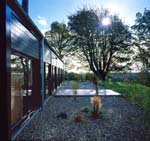 (Photo: Simon Jauncey) A slate and gravel patio extends the Cedar House living space into the garden.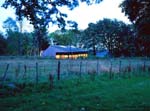 (Photo: Simon Jauncey) The house nestles into the landscape; its form is reminiscent of the barns and sheds scattered throughout the rural landscape. (Photo: Simon Jauncey) The main living spaces glow at dusk.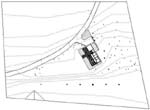 Site plan of the half-acre lot. Site plan of the half-acre lot. (Photo: Simon Jauncey) The entrance from the wooded, northeast side includes a sheltering portico large enough to park a small car. (Photo: Simon Jauncey) Light and shadows further blend the structure into the landscape. (Photo: Simon Jauncey) Sunsets reflect off the 11 sliding glass doors that lead from the garden to the main living spaces.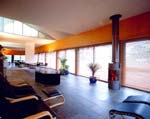 (Photo: Simon Jauncey) The expansive living/dining area has a wood-burning stove for cold winter days.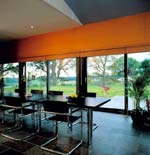 (Photo: Simon Jauncey) The dining area looks over the garden and rolling hills beyond.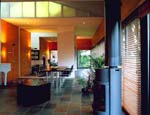 (Photo: Simon Jauncey) The mirrored wall with a translucent clerestory adds another dimension to the large living room; it is one side of a "box" housing two bathrooms.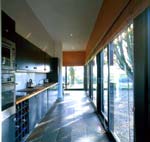 (Photo: Simon Jauncey) Even the kitchen has full access to the garden.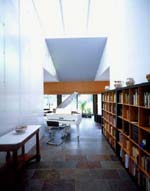 (Photo: Simon Jauncey) The ceiling through the center of the house is raised to match the slope of the roof.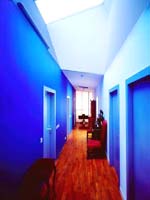 (Photo: Simon Jauncey) The main interior hall for the bedrooms and bath is wide enough for furniture, and fills with natural light from skylights and a translucent wall.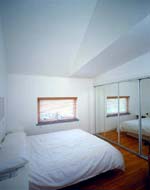 (Photo: Simon Jauncey) The bedrooms are very simple.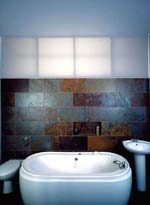 (Photo: Simon Jauncey) A bathroom is walled in slate.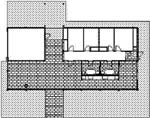 Floor plan Floor plan Section Section |
© 2002 ArchNewsNow.com